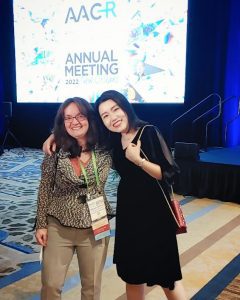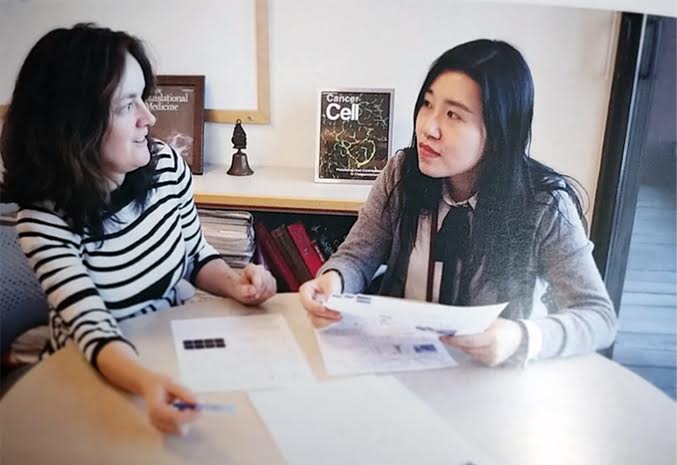Former CSHL researchers link stress-induced fibers with cancer in mice
By Daniel Dunaief
They both have left Cold Spring Harbor Laboratory, but the innovative research they did on Long Island and that they continue to do, is leaving its mark.

When Xue-Yan He was a postdoctoral researcher in the lab of Mikala Egeblad, who was Associate Professor at CSHL, the tandem, along with collaborators, performed innovative research on mice to examine how stress affected the recurrence and spread of cancer in a mouse model.
In a paper published in late February in the journal Cancer Cell, He, who is currently Assistant Professor of Cell Biology & Physiology at Washington University School of Medicine in St. Louis, discovered that stress-induced neutrophil extracellular traps (NETs), which typically trap and kill bacteria, trigger the spread of cancer.
“The purpose of our study is to find out what stress does to the body” of an animal model of cancer, said He.
The data in mice demonstrated that targeting NETs in stressed animals significantly reduced the risk for metastases, He explained, suggesting that reducing stress should help cancer treatment and prevention. The researchers speculate that drugs preventing NET formation can be developed and used as new treatments to slow or stop cancer’s spread.
To be sure, this finding, which is encouraging and has generated interest among cancer scientists and neurobiologists, involved a mouse model. Any potential application of this research to the diagnosis and treatment of people will take considerably more effort.
“I want to stress that the evidence for the link between stress, NETs, and cancer is from mouse studies,” Egeblad explained. “We will need to design human studies to know for sure whether the link also exists for humans.”
Still, Egeblad hopes that eventually reducing stress or targeting NETs could be options to prevent metastatic recurrence in cancer survivors. “One major challenge is that a cancer diagnosis by itself is incredibly stressful,” she explained. The results of these experiments have attracted considerable attention in the scientific community, where “there is a lot more to learn!”
Three part confirmation
When she was a postdoctoral researcher, He removed neutrophils from the mice using antibodies. Neutrophils, which are cells in the immune system, produce the NETs when they are triggered by the glucocorticoid stress hormone.
She also injected an enzyme called DNAse to destroy NETs in the test mice. The former CSHL postdoctoral researcher also used genetically engineered mice that didn’t respond to glucocorticoids.
With these approaches, the test mice developed metastasis at a much lower rate than those that had intact NETs. In addition, chronically stressed mice who didn’t have cancer had NETs that modified their lung tissue.
“Stress is doing something to prepare the organs for metastasis,” said He.
Linda Van Aelst, CSHL Professor and a collaborator on the study, suggested that this work validates efforts to approach mental health in the context of cancer.
“Reducing stress should be a component of cancer treatment and prevention,” Van Aelst said in a statement.
After He removed the primary tumor in the mouse models, the stressed mice developed metastatic cancer at a four-fold higher rate than the mice who weren’t stressed but who also previously had cancer.
The CSHL scientists primarily studied breast cancer for this work.
He appreciated the help and support from her colleagues at CSHL. “To really understand the mechanism” involved in the connection between stress and cancer, “you need a mouse model in the lab, an expert in neuroscience and an expert in the cancer field,” she said.
As a neuroscientist, Van Aelst offered suggestions and comments and helped He conduct behavioral tests to determine a mouse’s stress level. The work for this project formed the focus ofHe’s postdoctoral research, which started in 2016 and ended in 2023.
The link between stress and cancer is receiving increasing attention in the scientific community and has attracted attention on social media, He said.
CSHL “provided a great environment to perform all these experiments,” said He. The numerous meetings CSHL hosts and the willingness of principal investigators across departments made the lab “one of the best places” for a postdoctoral scientist.
“If you need anything from a neural perspective or a technical perspective, you can always find a collaborator” at CSHL, He added.
Born and raised in Nanjing, China, He enjoyed living on Long Island, visiting vineyards and trying to explore every state park. In the harbor, He caught blue crabs while her husband Chen Chen, who was a postdoctoral researcher at CSHL in the lab of Camila dos Santos, went fly fishing at Jones Beach.
In her current research, where she manages a lab that includes a senior scientist, a postdoctoral researcher and an undergraduate, He is extending the work she did at CSHL to colorectal cancer, where she is also analyzing how stress affects the spread of cancer.
“When you’re stressed, you can develop gastrointestinal problems, which is why I wanted to switch from breast cancer to colorectal cancer,” she said.
Extensions of the work
As for context for the research at CSHL, Egeblad wrote that doctors treating patients where the known risk of recurrence is high might use NETs in the blood as a biomarker.
The scientists think cancers that tend to metastasize to the liver, lung or spleen are the strongest candidates to determine the effect of NETs and stress on cancer.
“We have not seen any effects of targeting NETs for metastasis to the bone or the brain in our mouse model and similarly, the studies that have linked NETs to metastasis in human patients have mostly been cancer that has spread to the liver or the lung,” Egeblad said.
Egeblad appreciated the “fantastic job” He did on the work and described her former researcher as being “fearless.”
“She found that stress increased metastasis early in her project but it was a lot of work to discover it was the NETs that were responsible and to conduct studies to ensure that the results were applicable to different types of cancer,” Egeblad explained.
While the two researchers have gone to different institutions and are leading other lab efforts, Egeblad said she’d be happy to collaborate with her former student, who shares the same sense of humor.
Egeblad recalled how He ended her talks by telling the audience that her results showed that Egeblad should give her a “long vacation.”
“I think indeed that she has deserved one after all this work!” Egeblad offered.







